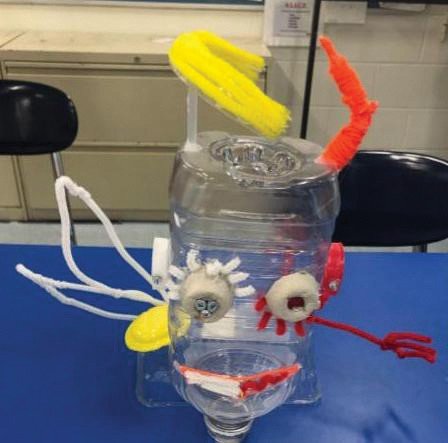

This sculpture made from trash in June by Bramble Ashton, Maggie Reed, Flannery Freeman and Holly Taylor depicts an angel and devil due to plastic’s reputation as good in the early 1990s and bad in the 21st century.
The school district is using its art program to remind students that one man’s trash is another man’s treasure.
Students at both schools are being tasked with designing a life-sized statue using recyclable material. The students will create smaller sculptures next week with artist Alex Perrine before that larger design is finalized.
The project is being led by seventh grade English teacher Brittany Richer Ahnrud. The goal is to show students they can use art to make a difference because the statue will send a message to the community about pollution.
“Art has an important role,” she said, “because it can say things that words can’t necessarily always say.”
The students will be creating the smaller sculptures with items collected and donated by families, teachers and businesses. These include Styrofoam packaging from The Secret Garden and wood scraps and a door screen from the Village Hearth Bakery. Central Garage, Cathryn Jamieson and the Curiosity Store also donated items.
“We’re trying to get everybody involved to collect some trash,” Ahnrud said. “Whatever supplies the kids have, that’ll inform what they end up creating.”


This sculpture of a turtle raises awareness about plastic pollution. The animal is covered in plastic bags, takeout boxes and straws.
The students will have free range to create whatever sculpture they want using the items made available to them in their art classes. The teachers are Erica Connolly at Melrose and Stephanie Pamula at Lawn.
Perrine grew up in Jamestown and graduated from the University of Southern Maine with a bachelor’s degree in fine art with a focus in sculpture. His mother, Susan, also is an artist who created a twig hut on the school’s property when she was younger.
Perrine has been creating sculptures from discarded objects for about 15 years. In his “Bodies of Waste” series, he uses trash to create depictions of human figures, including Greek and Roman gods and goddesses. He was inspired by Thomas Deininger, a Rhode Island artist who also uses trash and other found objects to create sculptures and paintings with an environmental message.
Perrine said he started using trash based on his desire to remove discarded plastic from the environment. The goal was to make people aware of the effect humans have on the Earth’s health.
Perrine, who usually builds his sculptures from the center out, likes to use ancient poses in his figures.
The impetus for the project was a teaching unit on plastic pollution in the seventh-grade classrooms. Former special education teacher Sandra Reynolds recommended Perrine and his work to Ahnrud. In June 2023, Perrine brought in one of his trash goddesses for the students to view. They were then tasked with writing about the sculpture and making their own versions.
Perrine was not able to repeat his visit in June because he was working in Colorado. He did, however, conduct a Zoom meeting with the students. They were curious about his artistic process and how it was a combination of a job and a hobby. During the summer, Ahnrud connected with Perrine and discussed her plan for students to design a sculpture based on his work.
“I wanted to do a large-scale sculpture,” she said. “Have the kids design it and commission it for him to make.”
Perrine has made a bear statue for a middle school in Colorado from local trash to raise awareness of environmental issues. He liked the idea of making a sculpture for the schools he went to as a child.
The Jamestown Education Foundation financed the sculptures created by students from kindergarten through eighth grade, which they will build next week. Because the seventh-grade unit on plastic pollution was the inspiration for the project, the students in other grades are looking at slideshows created by that grade.


“Trash Goddess” by Alex Perrine was temporary displayed at Lawn School as an example of a sculpture made from trash. Perrine, who attended the local school system, will help students design sculptures made from trash next week.
Next week, Perrine will visit both schools during the course of four days to explain his artistic process and provide feedback on the students’ sculptures in their art classes. Perrine said he is looking forward to watching the students have fun building their sculptures and learn about environmental issues and plastic pollution. He is looking forward to “doing these projects with the kids.”
“As a former student of both schools, it’s a big deal for me to come to my hometown as a visiting artist,” he said.
The larger sculpture will be created with support from the Jamestown Parent-Teacher Organization, which wanted to make sure it would benefit more than just the seventh-graders. The idea for a design contest, to include all students, came from that PTO request. Students will explain in their entry how their design is related to the pollution theme and the community. For example, Ahnrud said if the student came up with a wolf sculpture based on the schools’ mascot, they would designate what body parts would be made by which grade.
“We’re really incorporating all students,” she said.
Ahnrud said the contest will be introduced to the students at both schools after Perrine’s visit next week. The deadline will be in late November. Once the design is chosen, Perrine will work with the students while the sculpture is built. Students will be able to help with the different components of the project.
“Even if it’s not their day to be working on the sculpture, they’ll be able to see the sculpture in action developing day by day,” Ahnrud said.


